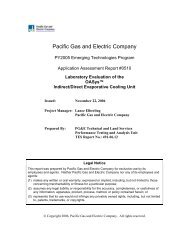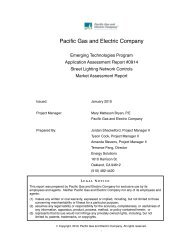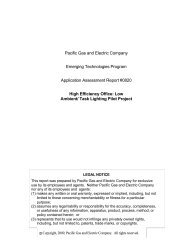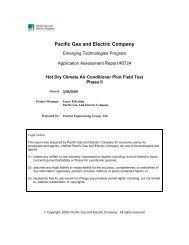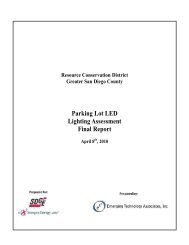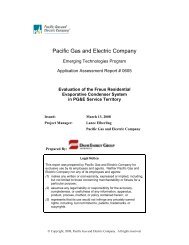Download the project report.
Download the project report.
Download the project report.
You also want an ePaper? Increase the reach of your titles
YUMPU automatically turns print PDFs into web optimized ePapers that Google loves.
<strong>the</strong>m), and <strong>the</strong> standard temperature conditions for <strong>the</strong> DOE Energy Factor test. In this example, <strong>the</strong><br />
break-even point for <strong>the</strong> net effect of cooling and standby loss is a daily use of about 8 gallons at a 77°F<br />
rise. At <strong>the</strong> Energy Factor standard quantity of 64.3 gallons, this example water heater would have a net<br />
cooling effect of 1.76 ton-hours per day, or about <strong>the</strong> same as running a 1-ton window air conditioner for<br />
1¾ hours. This relationship does not include <strong>the</strong> heating effect from direct contact of <strong>the</strong> produced hot<br />
water with <strong>the</strong> air in <strong>the</strong> space, such as from a shower or faucet, since this would normally not be in <strong>the</strong><br />
same area as <strong>the</strong> water heater.<br />
Economics<br />
The test results are conclusive that <strong>the</strong> heat pump water heaters will have an economic advantage over<br />
conventional electric resistance water heaters, by providing <strong>the</strong> same amount of hot water for as little as<br />
half <strong>the</strong> electric energy input. The size of <strong>the</strong> difference will depend on how <strong>the</strong> system is operated and if<br />
<strong>the</strong> use of <strong>the</strong> backup electric resistance elements is minimized. Heat pump water heaters also offer a<br />
significant demand reduction of as much as 3½ kW. However, <strong>the</strong> cost effectiveness in comparison with<br />
gas water heaters is less clear; and for most PG&E customers, gas water heating is still <strong>the</strong> most<br />
economical option.<br />
The analysis of cost effectiveness is complicated by PG&E’s tiered residential electric rate, where <strong>the</strong><br />
more energy is used, <strong>the</strong> higher <strong>the</strong> cost. The tiers are separated by a factor of a baseline quantity, which<br />
varies according to which of ten regions <strong>the</strong> customer is in, <strong>the</strong> season (summer or winter), and whe<strong>the</strong>r<br />
<strong>the</strong> customer has only electric service. Figure 22 shows an example of <strong>the</strong> current E-1 rate structure and<br />
how it varies with <strong>the</strong> baseline quantity. The customer’s average electric rate may be found as <strong>the</strong> slope<br />
of a line drawn from <strong>the</strong> origin until it intersects <strong>the</strong> appropriate trend.<br />
Comparing <strong>the</strong> cost of operation for different water heater systems may be done based on <strong>the</strong> knowledge<br />
that <strong>the</strong> Energy Factor rating represents a total hot water use of 150 <strong>the</strong>rms or 15 million Btu per year<br />
(64.3 gal/day × 77°F rise × 8.3 lb/gal × 1 Btu/lb-°F × 365 days/year). Using <strong>the</strong> conversion factor of<br />
3,412 Btu/kWh, this can also be figured as 4,396 kWh per year. The cost to operate ei<strong>the</strong>r a gas or<br />
electric water heater under <strong>the</strong> standard conditions is <strong>the</strong>n:<br />
Operating Cost: $/Year = [ 150 <strong>the</strong>rns/year / Energy Factor × $/<strong>the</strong>rm ]gas<br />
= [4,396 kWh/year / Energy Factor × $/kWh ]electric<br />
Assuming a customer is under <strong>the</strong> baseline amount and being billed at <strong>the</strong> current minimum of<br />
$0.11877/kWh (as of 3/1/2010), a heat pump water heater with an Energy Factor of 2.0 would have an<br />
equivalent operating cost as a gas water heater with <strong>the</strong> Title-24 minimum Energy Factor of 0.59 if <strong>the</strong><br />
average gas cost is $1.03 per <strong>the</strong>rm. The more electricity <strong>the</strong> customer uses, <strong>the</strong> less economically<br />
attractive it becomes, particularly if switching from gas to electricity pushes <strong>the</strong> user into a higher rate<br />
tier.<br />
The DEER database lists an average annual energy consumption for a 50-gallon standard electric water<br />
heater in a single family residence of 3,579 kWh, based on an average Energy Factor of 0.86. If for<br />
example, <strong>the</strong> Rheem unit operated always in heat pump mode and achieved an average Energy Factor<br />
close to <strong>the</strong> measured average 1.98, it would consume about 1,555 kWh/year; representing a reduction of<br />
2,024 kWh/year or 57%.<br />
491-09.17.doc 20



